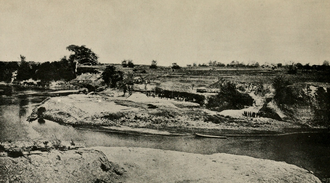Java Man
Java Man refers to early human fossils discovered on the island of Java, Indonesia. These remains were first uncovered in 1891 by the Dutch anatomist and geologist Eugène Dubois, who was searching for the "missing link" between apes and humans. Java Man is classified as Homo erectus, a species that lived from approximately 1.9 million to about 110,000 years ago. The discovery of Java Man was significant as it provided the first evidence of hominid life outside of Europe and Africa, challenging the then-prevailing Eurocentric view of human evolution.
Discovery
The first Java Man specimen, consisting of a skullcap, a femur, and a few teeth, was found near the Bengawan Solo River in East Java. Dubois initially named the specimen Pithecanthropus erectus, or "upright ape-man". These remains suggested that the creature walked upright and possessed a brain size roughly two-thirds that of modern humans. The discovery was met with skepticism at first, but subsequent findings of similar fossils in other parts of Asia gradually led to its acceptance among scientists.
Significance
Java Man played a crucial role in the development of paleoanthropology and our understanding of human evolution. The fossils provided concrete evidence that early humans lived in Asia, supporting the theory of a more widespread early human distribution than previously thought. Java Man also contributed to the understanding of Homo erectus as a key ancestor of modern humans, capable of using tools and adapting to different environments.
Morphology
The Java Man fossils indicate a creature with a mix of ape-like and human-like features. The skullcap showed a pronounced brow ridge and a brain size of about 900 cubic centimeters, smaller than that of modern humans but larger than that of earlier hominids. The femur suggested bipedalism, indicating that Java Man walked upright.
Later Discoveries
Further excavations in Java and other parts of Asia have uncovered more Homo erectus fossils, providing a broader picture of the species' morphology and behavior. These discoveries have shown a range of physical diversity within Homo erectus, suggesting a wide distribution and adaptation to different environments.
Controversy and Reinterpretation
The classification and interpretation of Java Man have undergone several revisions since its discovery. Initially thought to be a direct ancestor of modern humans, Homo erectus is now considered part of a more complex tree of human evolution, with multiple hominid species existing and interacting at various times.
Conclusion
Java Man remains a pivotal discovery in the field of human evolution, representing one of the earliest known species of the genus Homo outside Africa. The findings in Java have opened new avenues for understanding the spread and adaptation of early humans across the globe.
Transform your life with W8MD's budget GLP-1 injections from $125.
W8MD offers a medical weight loss program to lose weight in Philadelphia. Our physician-supervised medical weight loss provides:
- Most insurances accepted or discounted self-pay rates. We will obtain insurance prior authorizations if needed.
- Generic GLP1 weight loss injections from $125 for the starting dose.
- Also offer prescription weight loss medications including Phentermine, Qsymia, Diethylpropion, Contrave etc.
NYC weight loss doctor appointments
Start your NYC weight loss journey today at our NYC medical weight loss and Philadelphia medical weight loss clinics.
- Call 718-946-5500 to lose weight in NYC or for medical weight loss in Philadelphia 215-676-2334.
- Tags:NYC medical weight loss, Philadelphia lose weight Zepbound NYC, Budget GLP1 weight loss injections, Wegovy Philadelphia, Wegovy NYC, Philadelphia medical weight loss, Brookly weight loss and Wegovy NYC
|
WikiMD's Wellness Encyclopedia |
| Let Food Be Thy Medicine Medicine Thy Food - Hippocrates |
Medical Disclaimer: WikiMD is not a substitute for professional medical advice. The information on WikiMD is provided as an information resource only, may be incorrect, outdated or misleading, and is not to be used or relied on for any diagnostic or treatment purposes. Please consult your health care provider before making any healthcare decisions or for guidance about a specific medical condition. WikiMD expressly disclaims responsibility, and shall have no liability, for any damages, loss, injury, or liability whatsoever suffered as a result of your reliance on the information contained in this site. By visiting this site you agree to the foregoing terms and conditions, which may from time to time be changed or supplemented by WikiMD. If you do not agree to the foregoing terms and conditions, you should not enter or use this site. See full disclaimer.
Credits:Most images are courtesy of Wikimedia commons, and templates, categories Wikipedia, licensed under CC BY SA or similar.
Contributors: Prab R. Tumpati, MD





